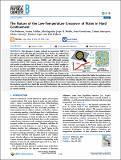Por favor, use este identificador para citar o enlazar a este item:
http://hdl.handle.net/10261/337934COMPARTIR / EXPORTAR:
 SHARE SHARE
 CORE
BASE CORE
BASE
|
|
| Visualizar otros formatos: MARC | Dublin Core | RDF | ORE | MODS | METS | DIDL | DATACITE | |

| Título: | The nature of the low-temperature crossover of water in hard confinement |
Autor: | Beilinson, Yael; Schiller, Verena; Regentin, Julia; Melillo, Jorge H. CSIC ORCID; Greenbaum, Anna; Antropova, Tatiana; Cerveny, Silvina CSIC ORCID ; Vogel, Michael; Feldman, Yuri | Fecha de publicación: | 2023 | Editor: | American Chemical Society | Citación: | Journal of Physical Chemistry B 127(22): 5128-5140 (2023) | Resumen: | The dynamics of water confined in mesoporous MIP (2–3 nm pores in size) with silica gel (secondary silica; further, the abbreviation SG will be used) and MAP (10–35 nm pores in size) without SG borosilicate glasses have been studied by broadband dielectric spectroscopy (BDS), nuclear magnetic resonance (NMR), and differential scanning calorimetry (DSC). MIP samples contain secondary silica inside the pores and provide a confinement size of about 2–3 nm, whereas MAP samples are free of secondary silica and provide a confinement size of about 10–35 nm. It is shown by BDS and NMR techniques that water exhibits a dynamic crossover of around 180 K when it is confined in MIP samples. By contrast, water confined in larger pores (MAP) does not exhibit any changes in its relaxation behavior. It is also shown that the crossover temperature depends on the hydration level (the higher the hydration level, the lower the crossover temperature). Below the crossover temperature, we find that water reorientation is isotropic (NMR) and that the temperature-dependent dielectric relaxation strength (BDS) follows the tendency expected for a solid-like material. In contrast, water reorientation is related to long-range diffusion above the crossover temperature, and the dielectric relaxation strength follows the tendency expected for a liquid-like material. Furthermore, the calorimetric results are compatible with crossing a glass transition near 180 K. Finally, the results are discussed within the Gibbs–Thomson model. In this framework, the crossover could be related to ice crystals melting. | Versión del editor: | https://doi.org/10.1021/acs.jpcb.3c00747 | URI: | http://hdl.handle.net/10261/337934 | DOI: | 10.1021/acs.jpcb.3c00747 | E-ISSN: | 1520-5207 |
| Aparece en las colecciones: | (CFM) Artículos |
Ficheros en este ítem:
| Fichero | Descripción | Tamaño | Formato | |
|---|---|---|---|---|
| natureconfine.pdf | 6,29 MB | Adobe PDF |  Visualizar/Abrir |
CORE Recommender
SCOPUSTM
Citations
5
checked on 18-may-2024
WEB OF SCIENCETM
Citations
3
checked on 23-feb-2024
Page view(s)
33
checked on 21-may-2024
Download(s)
18
checked on 21-may-2024
Google ScholarTM
Check
Altmetric
Altmetric
Este item está licenciado bajo una Licencia Creative Commons

